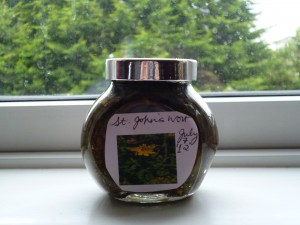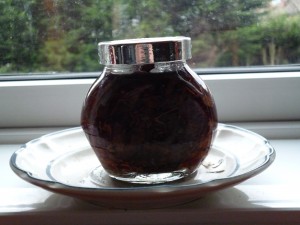By Lisa Smith
Earlier this month, I attended the newly revived Fairlop Fair, lured by the promise of dogs in silly costumes, bearded ladies, and Georgian medicine. My companions were leery of attending a medical herbalist’s workshop on eighteenth-century remedies, but the ominous clouds decided us: the workshop was undercover. I have studied early modern recipes for years, but this was my first attempt at making one.
To a modern person, old recipes are tricky to follow. Directions are frustratingly imprecise, while specific ingredients and tools are difficult to find or unsafe. There were also multiple recipes for the same remedy. Two recipes for Oil of St. John’s Wort from the popular collections of John Pechey (The London Dispensatory, 1694) and W.M. (The Queen’s Closet Opened, 1710) illustrate some of the possible differences. Pechey recommended infusing white wine, herb, and olive oil for three days in the sun. After repeating three times, the wine needed to be boiled, the mixture strained, and turpentine and saffron added. Then, one last boil.
Queen’s Closet suggested leaving a stopped glass with oil, white wine, herb, and oil of turpentine in the sun for ten days before boiling it ten to twelve hours. Next, the oil should be strained and more herb added. Another ten days in the sun and “this oil will then be of a deep red Colour, and will last seven years”. Both oils, nonetheless, treated similar problems: aches, bruises, sore limbs and joints, sprains.
But the recipe for Oil of St. John’s Wort shown to us by the medical herbalist appeared simple. We each took a couple handfuls of the herb, then stripped flowers and leaves and chopped them before jamming them into a small jar. Over that, we poured olive oil until it covered everything. The next bit needed to be done at home–putting the jar in the garden for three weeks. With the heat of the sun, it should turn brilliant red* and could be mixed into a base cream as an ointment for (surprise!) sore joints and wounds.
The exercise of making the remedy, however, highlighted problems in the timing, storage, and preparation of household remedies that I hadn’t considered. Steeping outside in the sun for three weeks sounds straightforward, but in London, we had grim weather between 7-20 July.
We also regularly get foxes in the garden, leaving the jar vulnerable to curious and messy scavengers.** I kept the jar on our fox-free and sun-trapping kitchen windowsill instead. Most early modern recipes don’t specify precautions for keeping the jar outside.
‘Handful’, moreover, was a common old measurement, but what does it measure exactly? We were told to take a couple handfuls of the eighteen-inch long stalks of herbs, but that provided only a handful of stripped leaves and flowers. Either way, it doesn’t sound like much until you physically handle the herb and realise that it takes a large quantity to produce a small jar. And St. John’s Wort was also a common ingredient in other remedies. Households, even with good-sized herb and kitchen gardens, would have needed to supplement their supplies by intensive gathering or purchase.
Academic historians can be a bit sniffy about historical reconstruction–but that is potentially a great loss. Of course we’ll never be able to recreate the production of early modern recipes exactly, but in the process of trying, we might actually learn something useful.
Now, to try my hand at some more easy recipes…
*Still waiting as of July 30, 2012.
**Perhaps I should have persuaded my husband to urinate in an area around the jar, an old (and effective) animal-deterrent.
UPDATE January 2013
Here is a dingy looking picture of the St. John’s Wort, six months later. The oil is actually a lovely shade of red, although this picture does not do it justice.
Will I be using it? Absolutely not! The jar lid is inferior and cracked on the side. Some of the oil over time has leaked away (hence the plate underneath). No doubt because of those problems, a layer of mold has started to grow on the top…
Next time, I’ll make sure to follow the directions more specifically. And to use a better jar.
Lisa Smith is an Associate Professor of History at the University of Saskatchewan. She writes on gender, family, and health care in England and France (ca. 1600-1800).



